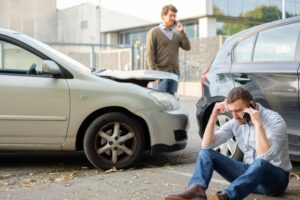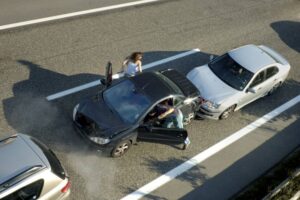Rear-End Accidents in Nevada

 Rear-end collisions are the most common type of car accident in the United States, making up a whopping 29% of all crashes. Rear-end accidents can occur in a variety of ways, from small bumps at red lights to high-speed freeway crashes. Considering how common rear-end collisions are, you’ve probably experienced one or more since you got your driver’s license.
Rear-end collisions are the most common type of car accident in the United States, making up a whopping 29% of all crashes. Rear-end accidents can occur in a variety of ways, from small bumps at red lights to high-speed freeway crashes. Considering how common rear-end collisions are, you’ve probably experienced one or more since you got your driver’s license.
If you were rear-ended in Las Vegas recently, you should know that you have options. If you act swiftly, an experienced Nevada personal injury attorney can assist you in filing an auto accident claim. Read on to learn more about how rear-end accident law works in Nevada, and what you can do to receive fair compensation for your injuries or property damage.
What Causes Rear-End Car Accidents?
Many rear-end accidents are caused by a driver tailing another car too closely. This driver is often found to be at fault because laws require that drivers stay a reasonable distance from the car in front of them. If a car is following other drivers too closely, they are not allowing for sudden stops or other emergencies.
In some rear-end accidents, both drivers are found liable. This can happen when one driver does not have working headlights, so the driver tailing them cannot tell when the vehicle is about to come to a stop.
Injuries Resulting from Rear-End Accidents
Car accident injuries can happen quickly, resulting from surprisingly little impact. Even if the car behind you barely hits your bumper, your neck might snap back and your head might hit the back of your car seat headrest, causing head pain or even whiplash. More severe accidents can, of course, lead to far more severe injuries, which can include some of the following:
- Head and neck trauma
- Broken or fractured bones
- Back and spinal injuries
- Whiplash or neck/shoulder pain
If you become injured in a rear-end collision, it’s important to see a doctor as soon as possible. A physician can diagnose even minor cases of whiplash, as well as more severe injuries like bone fractures. Visiting a doctor won’t just benefit your physical health—it will also come in handy if you decide to file an auto accident claim. Insurance companies and lawyers look at hospital records to ensure you get the compensation you deserve for your injuries.
Determining Liability and Compensation in Rear-End Accidents
The amount of compensation rear-end accident victims can receive depends on liability. Liability will be determined by participating insurance companies, who typically rely on police reports, witness statements, and surrounding traffic laws to make that decision. But as rear-end accidents are often cut and dry, the liability tends to be placed on the driver at the end of the pileup, or the driver who hit the car in front of them.
If a victim was determined not to be at fault for the accident, they will be compensated for their injuries or property damage under the at-fault driver’s auto insurance company. This compensation will be issued in the form of economic damages, non-economic damages, and punitive damages.
- Economic damages: Economic damages cover the costs of medical treatment and medical care. These may also cover lost wages if it is determined that a victim’s injuries affect their ability to work.
- Non-economic damages: Non-economic damages are awarded to the victim if it is determined that the accident caused pain and suffering or affected quality of life. This type of compensation typically covers emotional damages over physical damages.
- Punitive damages: Punitive damages might be awarded to the victim if it is determined that the at-fault driver was behaving negligently. This could include driving while drunk or even driving while texting.
Rear-End Accidents with Multiple Vehicles
 Some rear-end accidents involve multiple vehicles, such as when a car is hit from behind and pushed into the car in front of them. In the case of an accident like this, the vehicle at the end of the pileup is typically found to be at fault, as they are usually the driver who pushed the cars into each other.
Some rear-end accidents involve multiple vehicles, such as when a car is hit from behind and pushed into the car in front of them. In the case of an accident like this, the vehicle at the end of the pileup is typically found to be at fault, as they are usually the driver who pushed the cars into each other.
In this case, the driver at the very front of the pileup can make a claim against the driver at the very back, or even the driver in between. But, as with regular rear-end accident claims, the driver at the end of the pileup can make a claim against the car they rear-ended if there is evident of negligent driving.
Why You Need Experienced Legal Representation
If you or someone you know has been involved in a rear-end accident, the most difficult challenge will be determining who is liable in the accident. You need to know there are experienced, committed personal injury attorneys on your side. With more than 85 years of combined legal experience, the lawyers at Shook & Stone have the expertise to assist you in your rear-end accident claim. Call us today at (702) 570-0000 or contact us online for a free case consultation and rest easy knowing that you pay nothing until we win your case.